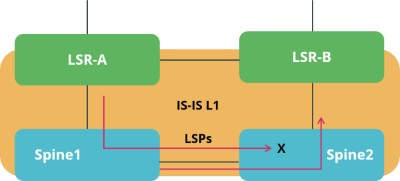IS-IS Overview
IS-IS, or Intermediate System to Intermediate System, is an open standard routing protocol. ISO published the standard as a way to route datagrams as part of their OSI stack. IETF later republished the standard, and added IP route support.
It is a link-state routing protocol, similar to OSPF. It forms neighbor adjacencies, has areas, exchanges link-state packets, builds a link-state database and runs the Dijkstra SPF algorithm to find the best path to each destination, which is installed in the routing table.
Segment Routing
IS-IS in RBFS supports segment routing based on RFC 8667. IS-IS segment routing extensions allow to advertise labels with prefixes.
| RFC and draft compliance are partial except as specified. |
RBFS currently supports the following IS-IS segment routing features:
-
MPLS data plane
-
IPv4 prefixes (TLV 135) and IPv6 prefixes (TLV 236)
-
Prefix SID with node flag (Node SID) on loopback interface
-
Anycast SID
-
A single global SRGB block
-
Adjacency SIDs
IS-IS Flood Filter Configuration
In IS-IS, by default all routers flood link-state packets, so that all routers will have a complete topology view. IS-IS flood filters allow to modify this behavior and limit the exchange of LSPs. For example, if two spine routers in a spine/leaf fabric are symmetrically connected to two upstream label-switch routers (LSR) like shown in the figure below, you can use a flood filter to not advertise LSPs learned from LSR A back to the LSR B via the second spine switch.
The flooding filter configuration is part of the global configuration hierarchy and therefore you can configure filtering globally, i.e. not per instance, so that the filter configurations can be reused across instances.
